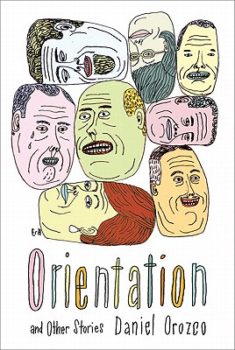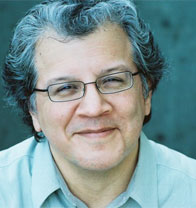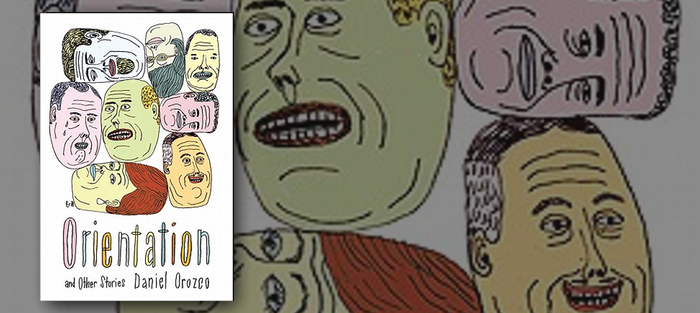Editor’s Note: For the first several months of 2022, we’ll be celebrating some of our favorite work from the last fourteen years in a series of “From the Archives” posts.
In today’s feature, J.T. Bushnell reviews Daniel Orozco’s debut collection, Orientation. The review was originally published on September 28, 2011.
If you’re like me, there are books you like and books you love, and then there are books that make you remember where you read them. This book is one of those. The nine stories in Daniel Orozco’s debut, Orientation, are so remarkable, so funny and dark and innovative, so smart and stirring and sad, that they left me pounding the sand on which my girlfriend and I had laid our blanket, muttering, “So good, so good.” We’d made a day trip to the Oregon coast to celebrate an anniversary, but I’ll remember nothing about the trip better than reading this collection.
I have, after all, been waiting for it since 2004. That was when I first came across Orozco’s short fiction in Harper’s Magazine. I was so stunned and moved and entertained that I hustled across the library to a computer, where I found another story of his in the archives of Zoetrope: All-Story. It was electric, mesmerizing. A couple years later I found another one anthologized in a text I was using to teach a fiction-writing course, then a couple years later a new one in a Best American anthology. Each time I was dazzled, and I searched for his book, eager to read more. But there was no book. Not until now.
Some fans have been waiting even longer. In a recent interview in Poets & Writers, Orozco, fifty-three, says that when his eponymous “Orientation” was selected for Best American Short Stories 1995, it raised a din from agents and publishers eager to see more of his work. The only problem? “There wasn’t anything else,” he says. It was his first published story.
 Even so, it elicited the same response from author Dan Chaon: “I became a fan of Daniel Orozco when I first read the story ‘Orientation’ back in the 1990s. I’ve been waiting eagerly for this collection ever since, and I’m so grateful to have it in my hands at last.” That’s a blurb from the dust jacket, but this is one of those rare books that lives up to its blurbs, that makes the effusive praise there seem accurate and reasonable.
Even so, it elicited the same response from author Dan Chaon: “I became a fan of Daniel Orozco when I first read the story ‘Orientation’ back in the 1990s. I’ve been waiting eagerly for this collection ever since, and I’m so grateful to have it in my hands at last.” That’s a blurb from the dust jacket, but this is one of those rare books that lives up to its blurbs, that makes the effusive praise there seem accurate and reasonable.
The stories are, first of all, hilarious. The writing is playful, full of satire and absurdity and insight. An employee at a temp agency is awarded “the assurance of permanent temporary employment.” When an earthquake hits, “The chimps on Monkey Island go ape-shit.” An office worker is instructed, “You are allowed to heat food in the microwave oven. You are not, however, allowed to cook food in the microwave oven.” When two officers arrest a man who has lost an arm, they “ponder a cop koan: How do you cuff a one-armed man?”
Even the forms of some stories emphasize the absurd. “Officers Weep,” comes in the form of a police blotter, delivered with corresponding objectivity, the point of view remaining impersonal even as the personal lives of the officers begin to emerge—their thoughts, their emotions, their burgeoning love for each other. They sass complainants, make bad jokes, flirt awkwardly, and the impersonal nature of the blotter, along with Orozco’s precision, makes it all very funny:
3600 Block, Sunnyside Drive. Vandalism. Handball courts in Phoenix Park defaced. Spray-paint graffiti depicts intimate congress between a male and a female, a panoramic mural of heterosexual coupling that spans the entire length of the courts’ front wall, its every detail rendered with a high degree of clinical accuracy. Officers gape. Minutes pass in slack-jawed silence, until officer [Shield #647] ascertains incipient boner. Officer horrified, desperately reroutes train of thought, briskly repositions his baton. Second officer [Shield #325] takes down Scene Report, feigns unawareness of her partner’s tumescent plight, ponders the small blessings of womanhood. Vandalism reported to Parks & Rec Maintenance.
But Orozco’s intention isn’t just to get us laughing at these characters. He adds emotional stakes by revealing the man’s “cautious and lonely life” and by letting us know that the woman feels “for the first time in a long while, yearned for, desired.” He adds gestures that show their happiness and connection—as they are beating back demonstrators, for example, they watch each other with admiration, smile, wave, stick out their tongues. Orozco also adds descriptions that resonate with their interior states, such as “the radio crackling like a comfy fire” while they park, watching the ocean. After consummation, they “watch a ball of sunlight flare up at earth’s edge like a direct hit,” and then “assess scene, ascertain world to be beautiful.”
But a complication is introduced just before this, when the officers take off their rings, suggesting this is something other than an innocent romp. The imagery grows more ominous—“a gash in the bruise-colored sky bleeds yellow”—and afterward the story darkens. They respond to a domestic disturbance, finding everything quiet except for “the robust glissandos of a chain saw.” The type of call—domestic disturbance—develops the complication. It calls forth associations with both the domesticity represented by their rings and the disturbances they have made—or responded to—with their liaison. The nature of the call, its insinuation of horrific violence, gives us a sense of the damage such disturbances can create. It echoes what these two officers might be facing in their own homes, or what they might face in the future if they build a home with each other. It also tests the strength of their connection. Will they risk an ultimate sacrifice in support of each other? It’s this sort of depth and complexity and loss that make these stories more than simple comedies.
 In many stories, characters are confronted with opportunities for connection and thereby forced to weigh the pain of loneliness against, worse, the pain of alienation. In a vignette from “Hunger Tales,” for example, a woman distracts herself from her loneliness by shopping for cookies at a sprawling, anonymous supermarket. One night she finds a woman like her in the cookie aisle. She longs for connection, but rather than making one here, she is horrified to have her loneliness exposed: “Nobody, she felt, needed to know that much about her.” In another vignette, a man is housebound by his obesity, but like the woman, he hates the presence of others more than he hates his isolation. It gives him the same sense of overexposure and shame to have firemen rescue him when he beaches himself on the floor, to have news crews wrestle him into a suit for interviews, to have a church group “cook his meals and wipe his ass and offer the only companionship he had.” In the end, he dreams of escaping all human contact, a wish that seems both reasonable and terrible.
In many stories, characters are confronted with opportunities for connection and thereby forced to weigh the pain of loneliness against, worse, the pain of alienation. In a vignette from “Hunger Tales,” for example, a woman distracts herself from her loneliness by shopping for cookies at a sprawling, anonymous supermarket. One night she finds a woman like her in the cookie aisle. She longs for connection, but rather than making one here, she is horrified to have her loneliness exposed: “Nobody, she felt, needed to know that much about her.” In another vignette, a man is housebound by his obesity, but like the woman, he hates the presence of others more than he hates his isolation. It gives him the same sense of overexposure and shame to have firemen rescue him when he beaches himself on the floor, to have news crews wrestle him into a suit for interviews, to have a church group “cook his meals and wipe his ass and offer the only companionship he had.” In the end, he dreams of escaping all human contact, a wish that seems both reasonable and terrible.
Likewise, in “I Run Every Day,” a shy and reclusive warehouse worker takes up running, and it changes him: “When I look in the mirror now, I see somebody who doesn’t disgust me.” It’s no coincidence that the activity he takes up—running—is a solitary one, and this affects his view of the world: “You get where you are by yourself. There’s no regret in that. That’s just the way it is.” But regret is exactly the subtext this passage creates with its defensiveness and resignation. And yet the greater distress for this character is the presence of others. When a new worker invites him to lift weights, initiating him into a group of friends, the protagonist retreats to a treadmill. Later, when he realizes he has let a secret slip, and the other warehouse workers tease him, he feels the same alienation as the cookie woman and the obese man: “I should have known what to expect from people. I should have known better.” And like them, he chooses isolation over companionship in the story’s chilling ending.
In many stories, the objective nature of the form enhances this conflict. The point of view is often distant and impersonal, even as the action dives into deeply personal arenas. No story demonstrates this better than “Orientation,” which takes the form of a monologue, a supervisor introducing a new employee to the building: “Those are the offices and these are the cubicles. That’s my cubicle there, and this is your cubicle.” He goes on to describe telephone policy, forms processing, kitchenette protocol. Like in “Officers Weep,” the form emphasizes regulation and procedure, uniformity and bureaucracy, and it gives Orozco the chance to lampoon those things. The supervisor explains, for example, that breaks are a privilege that can be revoked, but that lunch is a right. “If you abuse the lunch policy, our hands will be tied and we will be forced to look the other way. We will not enjoy that.”
But again, the story goes much deeper than simple satire. In the course of these impersonal introductions, the supervisor begins to drift into personal territory, describing the lives of other workers:
The men’s room is over there. The women’s room is over there. John LaFountaine, who sits over there, uses the women’s room occasionally. He says it is accidental. We know better, but we let it pass. John LaFountaine is harmless, his forays into the forbidden territory of the women’s room simply a benign thrill, a faint blip on the dull, flat line of his life.
The results are funny, but they’re also disturbing, because the detachment of the narrator highlights the separation that office bureaucracy imposes on its workers. The secrets become darker and more personal—love circles, sexual humiliation, stigmata, even a serial killer—and they are juxtaposed with explanations of the Mr. Coffee and the supplies cabinet, creating a strange combination of intimacy and detachment. Just after the narrator describes the hauntings performed by Barry Hacker’s dead wife and unborn child, for example, he says, “We have four Barrys in this office. Isn’t that a coincidence?”
One woman, Gwendolyn Stitch, decorates her cubicle with penguins, organizes social functions, offers professional and emotional support, but none of it breaks her isolation, or the bleak objectivity of the narrator:
Because her door is always open, she hides and cries in a stall in the women’s room. John LaFountaine—who, enthralled when a woman enters, sits quietly in his stall with his knees to his chest—John LaFountaine has heard her vomiting in there. We have come upon Gwendolyn Stitch huddled in the stairwell, shivering in the updraft, sipping a Diet Mr. Pibb and hugging her knees. She does not let any of this interfere with her work. If it interfered with her work, she might have to be let go.
In other words, the personal does not matter; only the work output does. Here are these people in close proximity, spending their time together, knowing the private details of one another’s lives and yet ignoring them, and thereby ignoring each other, retaining their isolation even within a crush of human need and longing. For them, personal intimacy creates separation rather than connection—the more intimately the characters know each other, the greater their alienation.
That theme runs through most of these stories, but each one bursts from the page fresh and invigorating and hilarious and heartbreaking. Orientation is, without question and without hyperbole, one of the best books I’ve ever read. I can’t find words emphatic enough that aren’t already printed on its dust jacket, but I can assure you that all the words there are true. Believe Anthony Doerr when he says, “Orozco can do anything [. . .] and I won’t be surprised when it becomes a cult classic.” Believe David Means when he says “‘Somoza’s Dream’ alone is worth the price of the ticket. But that’s not fair, because the same could be said of ‘Officers Weep,’ ‘Shakers,’ and every single story in this stunning piece of literary art.” Believe Julie Orringer when she says, “This may be Orozco’s first collection, but he’s nothing short of a master.”






